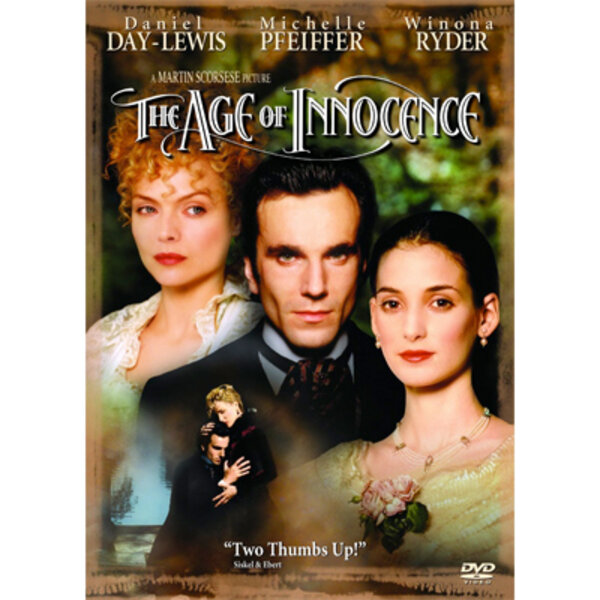Legendary director Martin Scorsese discusses 'The Age of Innocence'
Loading...
The Museum of the Moving Image’s See It Big series, curated in collaboration with Reverse Shot editors Michael Koresky and Jeff Reichert (Remote Area Medical), presented Thursday night, a 35mm print of Academy Award-winning auteur Martin Scorsese’s 1993 masterpiece, The Age of Innocence, starring Daniel Day Lewis, Michelle Pfeiffer and Winona Ryder. Based on the novel by Edith Wharton, The Age of Innocence is a love triangle between aristocrats and their social mores set in 1870s Manhattan. The film is a beautiful piece of art, a painting come to life, every single frame so carefully crafted from the makeup to the costumes to the set design, to the way the camera moves from one room to another, and to the incredible performances. I’m particularly in love with the shot of Michelle Pfeiffer as she’s standing on the docks by the lighthouse, and we see her from the point of view of Daniel Day Lewis, as he’s waiting to see if she’ll turn around and look at him as the boat passes.
This era (the 1990s, not the 1870s, mind you), happens to be one of my favorite. Other similar films to come out then that I extremely admire are Merchant and Ivory’s Howards End and The Remains of the Day, though these two are set in England. Like The Age of Innocence, these films also examine social manners between rich and poor, and have forbidden romances. Not to digress too much, but I think Anthony Hopkins gives his best performance ever, maybe one of the best in cinema history, in The Remains of the Day.
Scorsese came to the Museum Thursday night to do a brief introduction to the film. There was not a Q&A after the screening, but he eloquently reflected on his film, and what inspired him to make it. He said this picture goes a long way back. He has always been enthralled by films that are set in the past, usually the 19th Century. He’s enthralled by these characters that live in such a different world. Their thoughts, their emotions, all their conflicts. It was very immediate to him in and odd way. This connection of people in the past sheds humanity. It was a major desire of his to make a film that he wouldn’t call it a genre, but a period piece. Although he joked that everything he’s made is a period piece.
The first period film to really strike a blow with him was The Heiress, based on the novel by Henry James and directed by William Wyler. When he was two years old, his father took him to see it. Another film he admired was Albert Lewin’s The Portrait of Dorian Gray. He also loved The Innocents, which had an eerie quality. But all of these period films culminated in Visconti, particularly The Leopard (showing soon at the Museum from a restoration print).
Woven through all of these films like a thread during the 20 years he watched them, was filmmaker Max Ophüls. Letter From An Unknown Woman, a very melancholy, sweet film, was on television all the time until he was about 12 years old. Then later on, Le Plaisir and La Ronde. And in 1968, the restoration of Lola Montès, for which he said the late and great cineaste writer Andrew Sarris called it “the greatest film ever made.”
Scorsese said the style in all of these films is enveloped in narration. Narration is very important to him. The British film,. The satire of the British film, Kind Hearts and Coronets, with its sharpness, really led to Goodfellas.
In the early 1980s, screenwriter Jay Cocks, his old friend, gave him the book of The Age of Innocence, and by the time he read it, it was in England in 1985. He told Cocks when they started writing the script together that it’s a love story primarily. What’s important is the feeling and to nail the emotion right, not necessarily the setting. The challenge is to make a picture that stands on its own, but it doesn’t mean that it shouldn’t have references to the past art form.
Scorsese told the audience that if you’re young and you find this of any interest, you may seek out some of the films he was talking about and learn other filmmakers’ ways of thinking of other cultures and to see the universal connection of our shared humanity.
The Age of Innocence was a special film for Scorsese, one that he said he was very passionate about making, and was very special for a personal reason. It certainly changed his life in ways he didn’t expect. He loved Edith Wharton’s writing. It’s reflected in the use of narration, but he doesn’t think he can talk about Edith Wharton’s work without any real insight, except when he read it, it affected him deeply, and so he had to make the picture. It wasn’t easy to make. It was on and off for many years until finally Columbia Pictures put some money together and got a lot of incredible people to work on this film. Scorsese ended his introduction by thanking them all. Michael Balhaus, cinematographer, Dante Ferretti, production design, Gabrielle Pescucci, costumes, for which she won an Academy Award, Thelma Schoonmaker, editor, Elmer Bernstein, music, Saul and Elaine Bass, opening credits. Jay Cocks co-wrote the screenplay with Scorsese. They both show up as photographers in the film. And all of the actors. Joanne Woodward did the narration. Michael Gough and Alexis Smith, who played the van der Luydens, Robert Sean Leonard, Jonathan Pryce, Siân Phillips, Richard E. Grant, Geraldine Chaplin, Mary Beth Hurt, Miriam Margolyes, Alec McCowen, and the remarkable Norman Lloyd whose work goes back to Charlie Chaplin, Alfred Hitchcock and Orson Welles. At 97 years old now, he’s a nonagenarian tennis champion. And leads, Daniel Day Lewis, Michelle Pfeiffer, and Winona Ryder.
Brian Geldin blogs at The Film Panel Notetaker.







